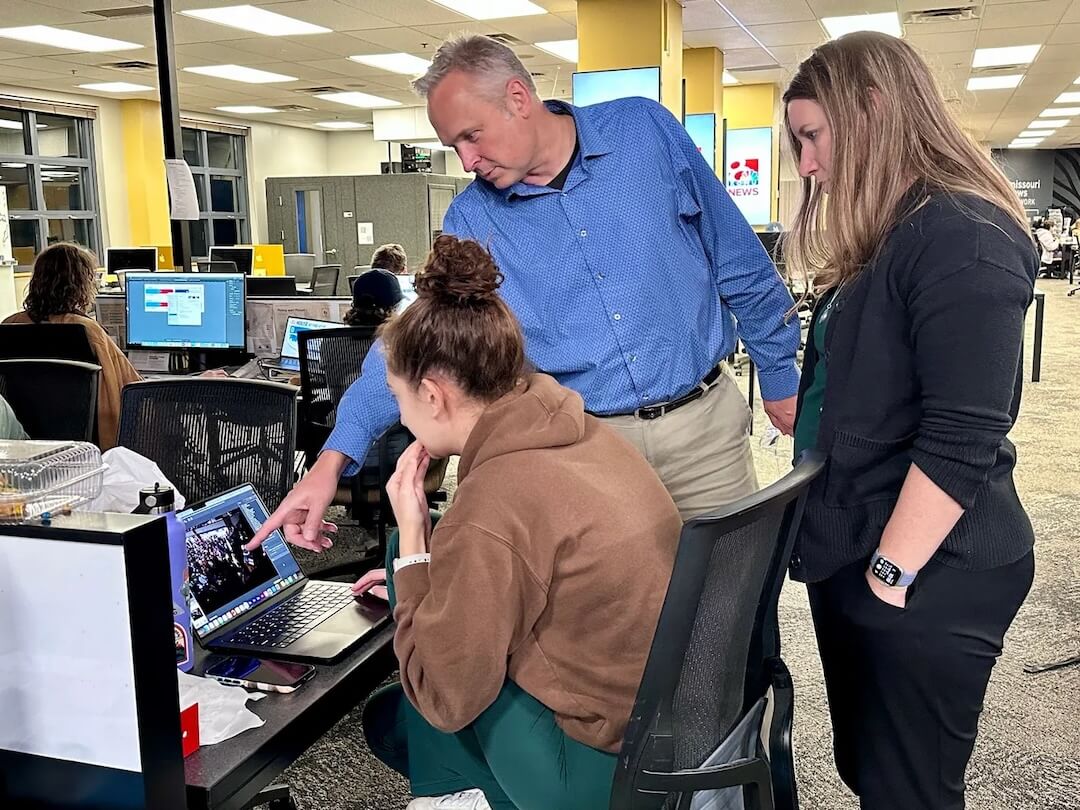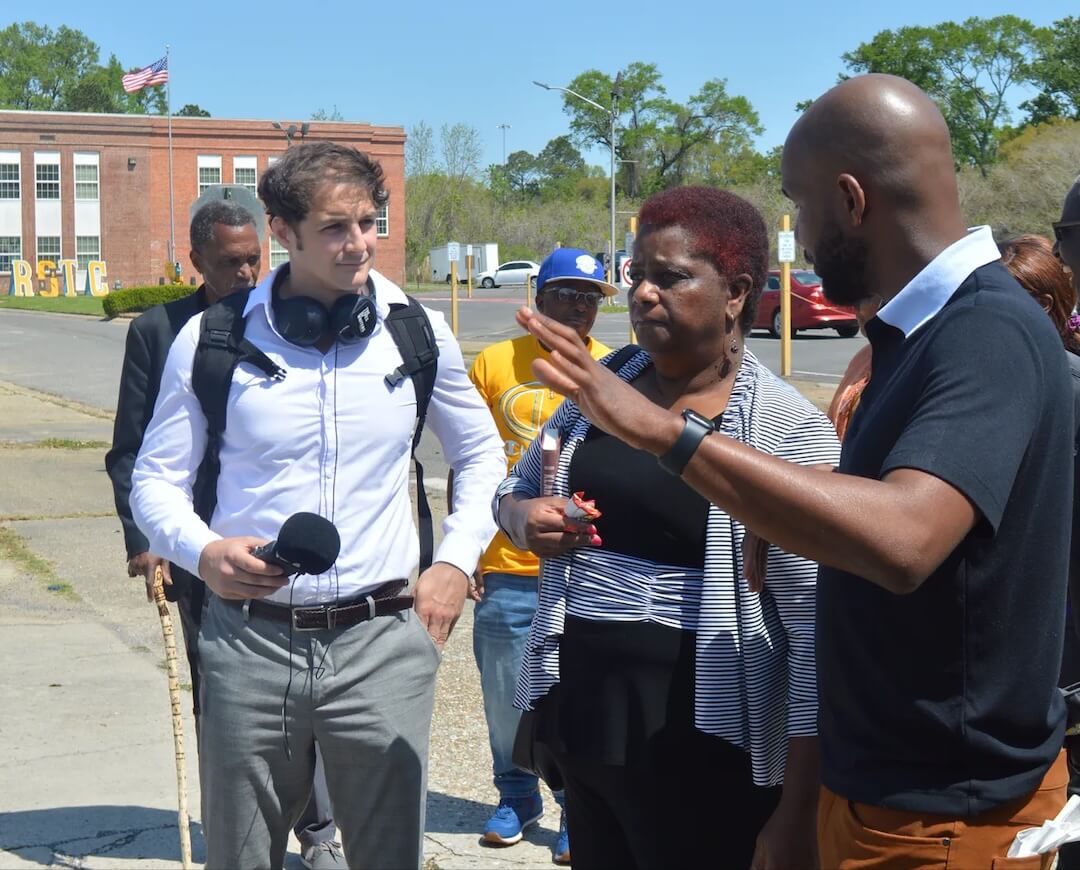This article was originally published by Northwestern University’s Medill Local News Initiative and is republished here with permission.
The old formula went like this: Journalism undergrads would learn in classes and maybe work on the school paper and then get professional experience via internships or summer jobs at news outlets.
But with the local news industry reeling, this dynamic has flipped. Instead of news organizations giving boosts to students, students are supporting often-short-staffed outlets by providing coverage as part of their curricula. This shift is happening as an expanding network of universities step up to offer students real-world journalism experience while creating what they hope will be a viable business model to fill local news gaps in communities that lack robust reporting.
The University of Vermont was not the first school with students providing local news coverage, but it is central to this burgeoning national movement. Richard Watts had noticed the dwindling number of news internships and mentorship opportunities available to his University of Vermont journalism students when he created the school’s Community News Service in 2019 to get them out into the surrounding communities to report.
“The basic point is to bring more of these experiences into the curriculum, so first and foremost, it’s about a high-impact experience for the students,” Watts said. “And then content is available for free to local media partners.”
Although Watts said the state of Vermont contains only one official news desert, according to the term’s definition by the Medill School at Northwestern University, many existing community papers, often locally owned, need help. “They’re still struggling to pay reporters for content, so whatever we do is a big plus,” Watts said. “These are certainly stories that no one else is reporting.”
The Community News Service provides edited copy to about 15 partnering local news outlets while posting the stories on its own website. These stories are meant to be shared. Beneath the byline is a “Republish” button, which offers a ready-made copy of the story plus guidelines for the republisher. For one, the outlet picking up the story must credit the reporter and Community News Service; if nothing else, the student reporter gets a professional clip out of the deal. Also, the outlet shouldn’t make significant changes to the copy without at least a discussion with the CNS editor and reporter.
Otherwise, the site notes: “Work by CNS students is published on our website and available for republishing by anyone, regardless of partner status.”
One such story, written by Alex Mcphedran and published March 10, has this grabber of a headline and subhead: “These Waterbury post offices are just 3 miles apart. Why are their P.O. box rates so different? The U.S. Postal Service has offered little explanation for the gulf in pricing.” In this case, Watts said, the Waterbury Roundabout editor suggested the story and got first dibs on publishing it. The Montpelier Bridge and Barre-Montpelier Times Argus went on to publish it as well.
Scooter MacMillan, editor of the bi-weekly Charlotte News in Vermont, said he appreciates the Community News Service’s contributions to his outlet.
“It’s been fantastic,” he said. “I’m the only full-time employee, so it gives us the opportunity to cover a lot more. It also gives us other voices.” With the students reporting on location and taking photos, he added, the stories have “much more of a local flavor” and feature more local people than when he’s doing everything himself. He said the Charlotte News runs about two student stories per issue during the school year
“I really do think it’s a profound thing that’s happening here,” he said. “In a way it’s sad we’re having to rely upon students, but on the other hand these students are getting wonderful experience, and the work they’re turning out is very professional.”
Going national
Viewing this formula as a win-win that could be replicated with other universities and news-strapped regions across the country, Watts founded and became director of the Center for Community News in 2022. This organization, also based at UVM, works with universities nationwide to grow their local news programs. Watts said about 150 universities or colleges are engaged in such programs so far. “Nearly 3,000 student reporters in university-led programs published more than 11,000 stories in local news outlets last year,” the CCN reports.
Watts said the Center for Community News moved into an “advanced phase” last July thanks to a $5 million grant from the Knight Foundation, with an additional $2 million to match other donations.
Penny Muse Abernathy — the retired author of two books and six State of Local News Reports, the last two for Medill — said she appreciates the impact of these efforts on news gathering, as well as on students learning “the glories of this profession.”
“Despite the drawbacks, I am very encouraged by the enthusiasm that’s being shown by the 150 or so schools,” Abernathy said. “It’s not only serving a public need, but it is potentially introducing the next generation of journalists who are going to make a significant contribution to our knowledge and the information that we need to become good citizens.”
University of Georgia journalism professor Amanda Bright had been working on a news-academic partnership at her school when she became connected to the Center for Community News. Three-and-a-half years ago, Bright said, a newspaper in an adjacent county to the university was about to close its doors, and an alumnus from the UGA’s Grady College of Journalism and Mass Communication proposed that the publisher hand over the paper to the school to make it a learning lab for students.
“We just built everything from scratch,” Bright said. “It definitely felt like building the plane while you were flying it. I didn’t realize that other people were doing the same thing.”
A year later, she came across the Center for Community News and was inspired to join Watts’ team. “I wanted to be part of building that out,” Bright said.
Bright created the CCN’s Resources for Faculty page, which offers tools and guidance for schools trying to develop news-academic partnerships. Materials include suggested program models, partnerships, syllabuses and curricula and ways to obtain and direct funding.
Bright said although the center counts 150 news-academic partnerships, “we know there are more. Every one of them looks radically different from the other.” Each one, she added, needs to “grab all the tools and resources and brain power to help people serving local communities with news and information.”
On her own local news front, Bright is assistant editor of the Oglethorpe Echo and works with reporters at the university-run newspaper in Georgia’s Oglethorpe County. The county is about a half-hour drive from the Athens-based campus and presented logistical challenges (students needed travel stipends to get there, so the school had to raise that money) and cultural ones.
“Oglethorpe County is a deeply red, conversative, agriculture-based county,” Bright said, noting that many UGA students are from Atlanta, and the young reporters have had to find ways to connect with the community they’re covering. “There’s a lot of distrust for big-M media. We had to be persistent in building that trust.”
Bright said the paper hosts an open house each semester so county residents can meet the ever-changing student staff. Typically, 15-20 community members show up and offer feedback, she said. “That’s so encouraging to us.”
Given that the Echo was down to a skeleton staff by the time UGA took it over, public officials were in for a change when the students rolled in. “Now we had 20 reporters assigned to a single county, and they were everywhere, asking questions,” Bright said.
Still, this approach has its limitations. “Because we have a new staff every four months, we do not often get to do the deep-dive accountability journalism that we’d like to be doing,” Bright said. “There are issues in the county that are ripe for good journalism.”
She said she would like to see the paper add a couple of professional staff members to provide more continuity to the coverage, as the University of Missouri has done. “We’re trying to figure out what our next move is now that we’ve got our feet under us,” Bright said.
‘The giant in this space’
The University of Missouri is the standard setter when it comes to students reporting local news. The Columbia Missourian, the newspaper affiliated with the journalism school, was founded in 1908 and maintains its mission of providing the community with journalism while serving “as a training ground for journalists and a lab for the broader industry,” its website notes. “We strive to prepare students to enter newsrooms as ethical journalists.”
“We’re a bit of the giant in this space because we’ve been doing it for so long,” said Elizabeth Stephens, the Missourian’s executive editor for the past three years and the Missouri Community Newspaper Management Chair, an endowed position at the university. “Nobody is going to start a newspaper in 2025 in this same way, but there are ways that universities can take some of this model and do it well.”
The Missourian has 10 faculty editors, a director of photography and other support staff for students who rotate through the program, Stephens said. These include two reporting classes totaling 60 students, who take shifts working on beats, plus about 20 photographers and 10 student editors. The faculty members oversee the students’ work to ensure consistency in the coverage.
The dominant paper in town had been the Columbia Daily Tribune, which the Watson/Waters family owned for 111 years before selling it to GateHouse Media (now Gannett) in 2016. Now, Stephens said, the Daily Tribune is “down to half a dozen newsroom staffers. It’s heartbreaking to watch a paper disappear like this.”

Brian Kratzer, center, Columbia Missourian director of photography; Elizabeth Stephens, Missourian executive editor, and Vanina Dimitrova photo editor and senior, discuss a front-page image on Election Night 2024 in the Missouri News Network newsroom. (Courtesy)
The Missourian has surpassed the Daily Tribune in circulation and become the community’s paper of record, Stephens said. But although the Misssourian has benefited in some ways from the Daily Tribune’s decline, she added, the student staff now lacks opportunities to work alongside and to try to scoop competing professional reporters.
Common to university-run news operations, the Missourian has another disadvantage in its coverage. “It’s tough when the staff turns over every four months,” said Stephens, a Mizzou faculty member for more than 13 years.
In some ways, the Missourian faces similar challenges to any other community paper. “We, the newspaper, have struggled the same way that the industry has,” Stephens said. “During the recession it was a tough time here, and the university stepped up to make sure this continues.” The paper continues to seek financial support to bolster its funding formula of subscriptions, ad sales, direct donations, university lab fees and the Missourian endowment.
Through the endowment of her Missouri Community Newspaper Management Chair, Stephens said she is able to support other community newspapers as well by running workshops, taking calls and offering counsel. “I always tell places: Start with what you know you can do,” Stephens said. “You can’t bite it all off in one go. We are fully covering everything a community newspaper can cover, and that’s not realistic for all schools.”
‘The schools are part of the community’
Christopher Drew has the Fred Jones Greer Jr. Endowed Chair at Louisiana State University, which enables him to fund ambitious journalistic work rarely experienced by undergraduate students. The university’s Manship School of Mass Communication has supported two long-term projects: The LSU Cold Case Project, in which students have been investigating unsolved civil-rights murder cases since 2009, and the Statehouse Bureau, which opened in 2016. The latter enables students to cover the Louisiana legislature for more than 80 news outlets throughout the state.
“Our students are basically the hometown reporters for most of the lawmakers from around the state,” said Drew, a New Orleans native who spent 22 years as an investigative reporter and editor at The New York Times, winning a George Polk Award in the process.
Drew said that over the past few years, as news sites around the state have lost staff and resources, more and more outlets have appreciated receiving the students’ copy. “They’re all desperate for content, but none of them have time to take on interns or to edit student content themselves,” Drew said. “What the editors would always tell me is ‘Not only do we appreciate the coverage, but we appreciate that you edit the stories, so when they come to us, they’re ready to go.’”
Now Drew is working to create a network of universities around the state, with LSU as the flagship providing money and support. Boosted by a two-year $400,000 grant from the MacArthur Foundation and a $225,000 grant from the Henry Luce Foundation, the program was launched in March with eight universities participating: four historically black colleges and universities, three smaller state schools plus LSU. Drew said LSU students work in collaboration with students at Southern University, an HBCU based in Baton Rouge, to cover the state capital’s minority community.
“Our goal was to see if we could create a model that could be replicated in other states, where you could bring some universities together,” Drew said. “The basic idea was as the number of professional reporters dwindles everywhere, where could we turn for reinforcements? The schools are right there; the schools are part of the community; it’s not like outsiders coming in. They can provide all this coverage that the papers can’t do.”
The reintroduction of reporters to these communities could have other positive effects as well. “People are interviewed by reporters and realize reporters are just regular people, and hopefully that might rebuild some trust, because a lot of these locations, if they’re not news deserts, they’re near news deserts,” Drew said. “We wanted students to get the experience so more students would get into journalism.”

Drew Hawkins, then a master’s student at LSU, interviews two members of Denver Smith’s family — Josephine Smith and Denver Terrance — near a memorial marker at Southern University for the LSU Cold Case Project. Denver Smith, a Southern University student, was shot and killed during a campus protest in 1972. (Courtesy)
At the beginning of the current academic year, the Medill School at Northwestern University launched its own effort to have students boost reporting for local outlets on state government and help fill the void of a decimated Statehouse press corps in Springfield, Ill. The Medill Illinois News Bureau included four students in the fall quarter, 10 in the winter quarter and seven — including two undergrads — in the current spring quarter, director Bob Rowley said.
The effort is a collaboration with Capitol News Illinois, a nonprofit news service created in 2019 by the Illinois Press Foundation, and has received support from the McCormick Foundation. Rowley said when Medill students report a story, it goes out to 700 Illinois news outlets in the Capitol News network and can show up anywhere from the Belleville News-Democrat to the Pantagraph in Bloomington-Normal to Chicago’s PBS station, WTTW, to various radio stations. These pieces have garnered tens of thousands of page views, including almost 16,000 for one story, he said.
“This is not solving the overall problem, but it is a substantive way to do something concrete and meaningful to help fill gaps in local news coverage and bolster news about the Illinois statehouse and Illinois state news,” Rowley said, noting that it provides meaningful experiences to students as well. “This is another mission-driven way to help in a time of tumultuous disruption.”
Watts agreed. “What makes these programs an important part of the solution is that they are building on existing infrastructure using existing resources, simply directing them more externally than internally,” he said. “Many of these students may not go on to be reporters. but at the end of the day, they’ll be more informed citizens.”
Spreading the model
Denison University, located in the rural village of Granville, Ohio, is a relative newcomer not only to local news reporting but to journalism itself. The school didn’t even offer a journalism major and minor until the 2021-22 academic year.
“We went from zero majors to 80 majors and 20 minors in three years, which says something about the interest in this form of journalism,” said Alan Miller, who retired as the Columbus Dispatch’s executive editor in 2022 to join Denison’s journalism faculty full-time after having taught there part-time for 22 years.
The driver in Denison’s journalistic efforts is the Reporting Project, which covers the surrounding Licking County. Miller said Denison boasts the rural county’s largest newsroom, with 12 students comprising the Reporting Project staff. Most are paid, with two of them receiving school credit rather than money.
The resultant stories are free for any news organization to publish. Miller said the Gannett-owned Columbus Dispatch, Newark Advocate, Granville Sentinel and Pataskala Standard “regularly run the stories we produce. It puts a megaphone on what we’re doing here.”
“We just want as many eyes on our stories as possible,” Reporting Project managing editor Julia Lerner said. “We have people covering communities that haven’t had reporters there for decades.”
This rural area has generated plenty of news, especially since Intel announced in 2022 that it would be building a since-delayed $28 billion semiconductor plant in the county. Other project announcements — such as for asphalt mixing facilities and gas-fired electricity-generating plants — followed, with serious environmental implications that the Reporting Project has explored.
“The towns were reeling but also immensely grateful to us for the coverage because otherwise they wouldn’t have known,” Miller said.
Aside from using the Otter.ai transcription service, the Reporting Project prohibits artificial intelligence as a tool to assist its reporting, such as by covering and summarizing meetings. “I think the most important thing we can do is physically show up at these meetings and make our presence be known,” Lerner said. “People see us week after week after week, they trust us more. They know we’re just as much a part of their community as they are.”
Added Denison journalism director Jack Shuler: “There are a lot of officials who haven’t had a reporter call them in years. We are ambassadors for journalism in this community. We are out there teaching folks about what journalists do.”
Student journalists have gotten involved in community news in ways unrelated to university programs as well. The Daily Iowan, the independent student-run paper at the University of Iowa, bought two local papers in February 2024: The Mount Vernon-Lisbon Sun and the Solon Economist. All three papers now fall under the ownership of Student Publications, Inc., an Iowa City-based nonprofit.
The news-academic model is even being pursued in areas rich with media. In Boston, the Northeastern University School of Journalism operates the Scope, where undergraduate and graduate students report on justice and equality issues often overlooked by other outlets. “It was the first thing I was asked to do when I joined the faculty at Northeastern in 2017,” said Meg Heckman, the Scope’s faculty advisor and Northeastern’s Graduate Programs Director.
A Poynter-Koch Media and Journalism Fellowship funded a full-time editor-in-chief for a one-year term, and a $100,000 Press Forward grant awarded last October is “allowing us to continue to pay a part-time editor-in-chief at least through the middle of 2026,” Heckman said. “Without that kind of outside grant funding, we would not be able to run the Scope.”
Heckman sees a couple of factors fueling this “growing movement” of news-academic partnerships. “There is more interest in experiential education and practical application of skills taught in classrooms and a growing awareness of the need to revitalize the local-news ecosystem,” she said.
But, she warned, schools must have “real conversations” about supporting faculty and staff to ensure this model’s sustainability. “Local news is real work, and it’s not something that can be absorbed into the existing faculty workload,” Heckman said. “It can’t be absorbed into a standard teaching load. It can’t be done on top of everything else journalism educators are called upon to do. It needs to be viewed as legitimate work by journalism professionals. Unfortunately, a lot of institutions don’t see it that way.”
Teri Finneman at the University of Kansas appreciates Heckman’s point about the need for university faculty to be able to balance class work with journalistic duties. Aside from having a full teaching load as a journalism professor, Finneman is publisher and executive editor of the Eudora Times, a digital news outlet launched six years ago in a small city that lost its community newspaper about 10 years earlier. Finneman said she supervises four to six students and edits every one of their nine to 15 pieces published each week.
“I have two full-time jobs, yes,” Finneman said. “I mostly do this for free.”
The Eudora Times has raised about $130,000 in donations since its launch while also receiving support from Poynter-Koch and the Knight Foundation, plus a little ad revenue, Finneman said. She noted that the money goes to support four students on staff who are guaranteed to receive stipend money each semester.
There are no classes associated with the Eudora Times; it’s more of an extracurricular activity. On the bright side, that means students have stuck around for two years instead of just a semester, Finneman said. The challenge is covering breaking news on a student’s schedule.
“If there’s a fire, and my students are sitting in philosophy class, there’s not much I can do about that,” Finneman said.
Finneman, Heckman and Pamela E. Walck at Duquesne University co-authored a 2022 paper, “Reimagining Journalistic Roles: How Student Journalists Are Taking on the U.S. News Desert Crisis.” It views these news-academic partnerships as “not only a potential solution for addressing news deserts but a reimagining of the conceptual and practical roles of student journalists.”
Finneman said she and Walck now are writing a book together called “News Desert U,” due out early next year. It will include six case studies of university-related news efforts in rural and diverse communities. “Our central question of the book is ‘What does it mean when the university owns the news?’” Finneman said.
Back in Vermont, Watts envisions the news-academic movement spreading further. “One logical next step is to decentralize this to the state or regional level,” Watts said. “We’re only national. If you had a university system or a state-led effort, it would bring in more schools.”
For example, he noted, the State University of New York system is the country’s largest comprehensive state system, with 64 campuses. It has established the Institute for Local News at SUNY, which “engages students in university-led reporting programs with local media partners to bolster local news coverage while giving students real-world learning experiences in multimedia story-telling and communications.” Its website highlights reporting programs at multiple campuses, and if you click on “Add or Create a Campus Program,” you are directed to a Center for Community News form that collects information about collaborations among colleges, universities and media organizations.
The potential exists to do much more.
“Right now, we have maybe 150 programs, but there are 6,000 colleges,” Watts said, noting that 1,316 schools nationwide are in news deserts or are news desert adjacent. “There are more opportunities for more programs to step up and give students the high-impact learning experiences they crave and to contribute to local news.”








Comments